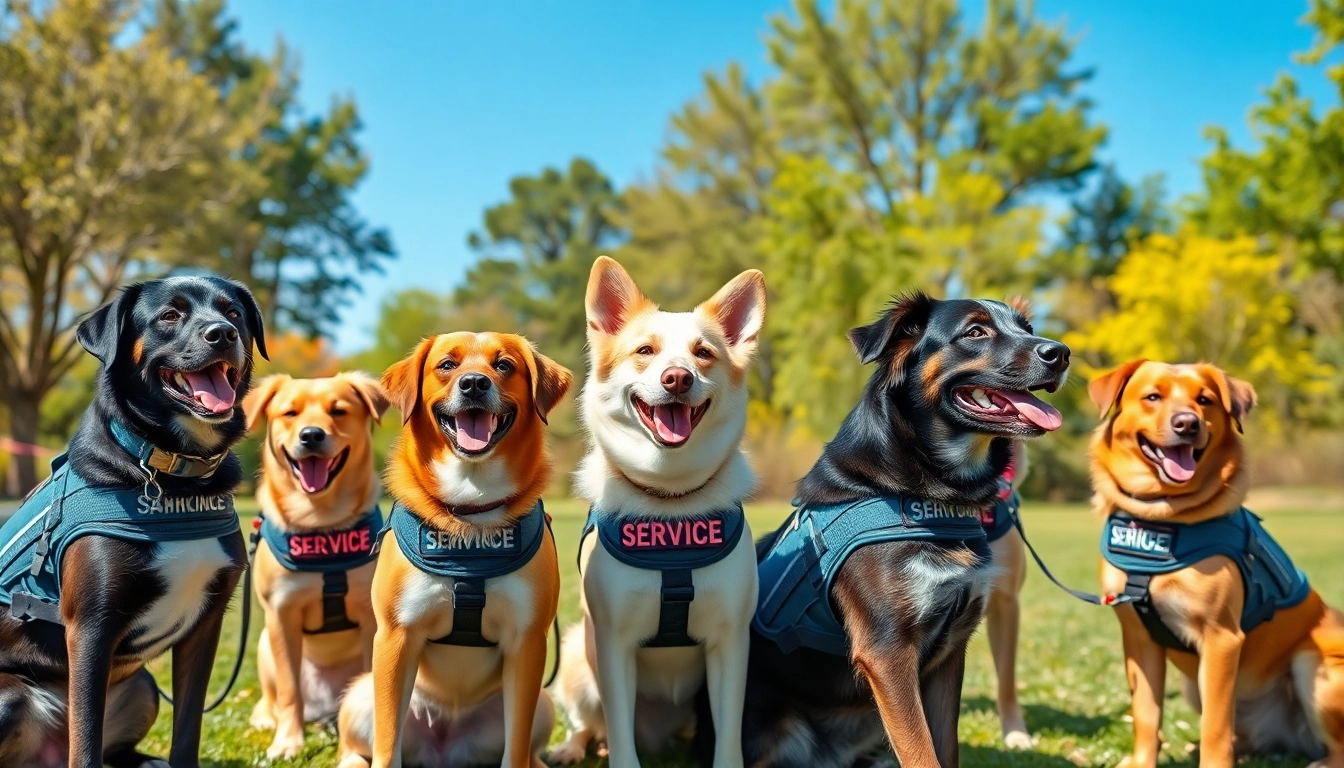Understanding Service Dogs
Service dogs are more than just pets; they are trained companions that provide essential support for individuals with disabilities. These incredible animals perform specific tasks that mitigate their handler’s disability, which can range from mobility assistance to psychiatric support. The demand for service dogs for sale has surged in recent years as people recognize the critical role these canines play in improving the quality of life for those in need. In this comprehensive guide, we will delve into the various aspects of service dogs, from their definitions to the essential considerations when looking to acquire one.
What Defines a Service Dog?
A service dog is defined by the Americans with Disabilities Act (ADA) as a dog that has been individually trained to perform tasks for a person with a disability. These disabilities can be physical, sensory, psychiatric, or intellectual. Unlike emotional support animals or therapy dogs, service dogs have specific rights and access to public spaces due to their training and the nature of their duties.
These dogs are trained to carry out a variety of tasks that directly assist their handlers, such as guiding visually impaired individuals, alerting deaf owners to sounds, or fetching items for people with mobility challenges. The key distinguishing factor of a service dog is its training and the tasks it performs that alleviate its handler’s disability.
Types of Service Dogs Available
There are several types of service dogs, each trained to help individuals with specific needs:
- Guide Dogs: Assist individuals who are blind or visually impaired by navigating obstacles and guiding them safely.
- Hearing Dogs: Alert individuals who are deaf or hard of hearing to important sounds, such as doorbells or alarms.
- Mobility Assistance Dogs: Provide support to individuals with physical disabilities by performing tasks such as retrieving items, opening doors, or providing stability during walking.
- Psychiatric Service Dogs: Help individuals with mental health conditions, such as PTSD or severe anxiety, by providing grounding techniques or alerting them to oncoming panic attacks.
- Seizure Alert Dogs: Can sense an impending seizure and alert their handler or others nearby, allowing for safety measures to be taken.
The Role of Service Dogs in Daily Life
The role of service dogs extends well beyond their training; they offer emotional support, companionship, and a sense of independence. For many individuals, a service dog can mean the difference between a limited lifestyle and one filled with mobility and freedom.
Service dogs can help their handlers navigate social situations more confidently, participate in activities they may have otherwise avoided, and feel a stronger connection to their community. As such, the impact of a service dog is profound not only on the individual but also on their families and friends, reshaping how they engage with the world around them.
Factors to Consider When Buying Service Dogs for Sale
Assessing Your Needs for a Service Dog
Before acquiring a service dog, it’s crucial to assess your specific needs. Understanding how a service dog will fit into your lifestyle is the first step in the decision-making process. Considering your daily routines, your living situation, and the specific tasks you require assistance with will help you identify the right type of service dog for you. Questions to consider include:
- What specific tasks will the dog need to perform to assist me?
- Do I have the necessary living space for a service dog?
- Am I emotionally and mentally prepared to integrate a service dog into my life?
- What is my budget for purchasing and caring for a service dog?
Evaluating the Dog’s Training and Capabilities
Once you’ve assessed your needs, the next step is to evaluate the dog’s training. You should seek a dog that has been trained by a reputable organization, ensuring that the training meets industry standards and is suitable for your specific needs. Look for dogs that have been trained in the following areas:
- Basic obedience commands (sit, stay, come)
- Specific task training related to your disability
- Socialization skills and comfort in public environments
- Behavioral stability and temperament necessary for service dogs
It’s vital to ensure that the dog is capable of performing the tasks you require and that they have been socialized properly to interact safely and comfortably in public spaces.
Your Budget for Service Dogs for Sale
The cost of acquiring a service dog can vary greatly depending on the training and the organization you choose. It’s essential to establish a budget before beginning your search. Some factors influencing the price may include:
- The dog’s breed and age
- The length and complexity of the training provided
- Additional costs such as veterinary care, food, and training supplies
- Potential follow-up training sessions or support services
Understanding these costs will help you set realistic expectations for your investment in a service dog.
The Process of Acquiring Service Dogs for Sale
Finding Reputable Breeders and Organizations
Finding a reputable source for your service dog is critical. Start your search by looking for organizations that have been accredited by recognized service dog training standards. These may include non-profits that specialize in training service dogs or accredited breeders who focus on temperament and health. Look for the following attributes when evaluating potential sources:
- Established history and success stories
- Positive testimonials and recommendations from past clients
- Transparency regarding training methods and protocols
- Commitment to socializing dogs in various environments
Steps in the Application and Evaluation Process
Upon identifying potential breeders or training organizations, you will usually need to fill out an application or questionnaire to assess your suitability for a service dog. This process may involve:
- A detailed questionnaire regarding your needs and lifestyle
- An evaluation of your physical and mental health needs
- Interviews and potentially home visits by the organization
- A waiting period, as many organizations have long lists of clients seeking service dogs
Transitioning Your New Service Dog into Your Life
After being approved for a service dog, the next step is the transition process. Introducing a service dog into your home and daily routine takes time and adjustment. Consider the following strategies during this phase:
- Establish a consistent training and command routine so the dog understands expectations.
- Gradually expose the dog to different environments that you frequent, such as your home, work, and other social settings.
- Communicate openly with your service dog trainer regarding any challenges you encounter during this adjustment period.
- Be patient as both you and your new service dog learn to work together effectively.
Common Misconceptions About Service Dogs for Sale
Myths vs. Facts about Service Dogs
- Myth: Any dog can be a service dog.
- Fact: Only dogs specifically trained to assist their handlers’ disabilities can be classified as service dogs.
- Myth: Service dogs are just for blind or physically disabled people.
- Fact: Service dogs assist people with various disabilities, including mental health conditions.
- Myth: Service dogs do not need training and can be self-trained.
- Fact: Service dogs require extensive and specialized training to effectively assist their handlers.
The Legal Rights of Service Dog Handlers
Service dog handlers are afforded certain legal rights under the ADA. These rights include:
- The right to access public places with their service dog.
- Protection against discrimination based on their disability.
- The ability to be accompanied by their service dog in housing situations.
It is essential for service dog users to understand their rights to advocate for themselves and ensure their needs are met.
Debunking Myths Around Service Dog Training
Debunking any misconceptions surrounding service dog training is vital for current and prospective dog handlers. Some important training truths include:
- Training can last several months to years, depending on the individual dog’s capabilities and the task complexity.
- Certification is often not required, but it can help in demonstrating the dog’s training to businesses and public venues.
- Positive reinforcement is usually the primary method used in training service dogs, resulting in a well-adjusted canine.
Resources for Prospective Dog Owners
Support Groups and Community Resources
Many communities offer support groups and resources for those acquiring or living with service dogs. These can be incredibly beneficial for sharing experiences and gaining insights from others in similar situations. Resources might include:
- Local and national support groups focused on service dogs
- Online forums dedicated to discussions about service dogs and their training
- Meetup groups where service dog handlers can connect and socialize
Training Programs Tailored for Service Dogs
Various organizations specialize in service dog training programs that help prepare both dogs and handlers for successful partnerships. Consider the following aspects when selecting a program:
- Look for accredited programs recognized by industry standards.
- Inquire about the training techniques employed and whether they focus on positive reinforcement.
- Ask about the types of support offered post-training, such as ongoing education and training for the handler.
Helpful Online Platforms for Service Dogs for Sale
Lastly, many online platforms can serve as resources when searching for service dogs for sale. Online searches can connect you to reputable breeders or organizations specializing in service dogs, often providing profiles of available dogs, their training backgrounds, and how they might suit your needs. Platforms may also offer educational resources and forums for connecting with other service dog owners.



